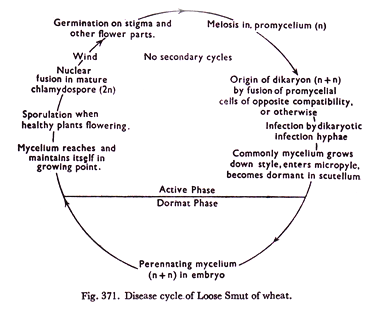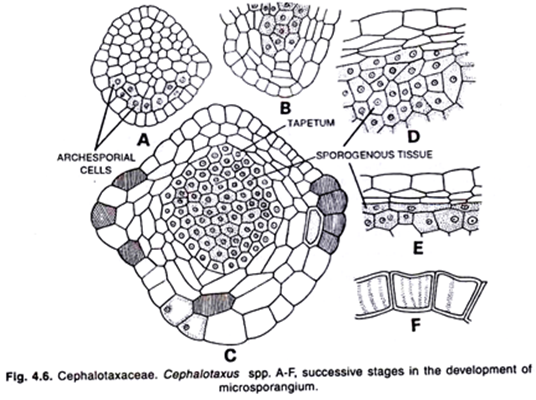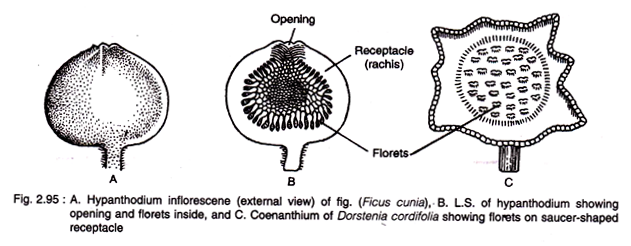In this essay we will discuss about the process of inflorescence in flowers.
Essay # 1. Meaning of Inflorescence:
Flowers are arranged in various ways in different plants. The arrangement of flowers on the floral axis (shoot system) of a plant is called inflorescence.
The character of inflorescence (Fig. 2.79) has profused taxonomic significance. This characteristic is found to be constant in a number of families and helps in taxonomic identifications, e.g., capitulum in Asteraceae, verticellaster in Lamiaceae (Labiatae), umbel in Apiaceae (Umbelliferae) etc. In some cases it helps to identify the genera like Hamelia of Rubiaceae with helicoid cyme and Heliotropium of Boraginaceae with scorpioid cyme etc.
The main axis or stalk of a solitary inflorescence is called the peduncle (Fig. 2.79A, D). In many cases, the main axis branches out and bears flower at the branch apex, the main axis is called peduncle and the stalk of individual flower is called pedicel. A long, simple or branched peduncle is called a rachis (Fig. 2.79D). The small central axis of a grass or sedge spikelet is called rachilla.
The unbranched naked peduncle developing from the underground stem is called scape or radical peduncle (Fig. 2.79C). The flower with pedicel is called pedicellate flower and those without them are called sessile flower. The dilated or flattened peduncle is called receptacle (Fig. 2.79E).
The stage or platform on which the floral parts situated is called thalamus. The conical receptacle is called torus. Inflorescence with unbranched peduncle is called simple inflorescence and if branched, it is called compound inflorescence.
Sometimes, the flowers as well as inflorescences are subtended by an expanded leafy organ, called bract and flowers having bract is called bracteate flower and without bract it is called ebracteate flower. Sometimes, very small thin bract-like (leafy or scaly) structures are developed on flower stalk in between flower and bracts, called bracteoles or secondary bracts.
Types of Bracts:
Bracts are of different types.
These are:
a. Leafy or Foliaceous:
These bracts are typically green leaf-like, e.g., Acalypha indica (Fig. 2.80A, B) of Euphorbiaceae etc.
b. Scaly:
These bracts are thin and scale-like, e.g., disc florets of capitulum inflorescence in Helianthus annuus of Asteraceae (Fig. 2.80C).
c. Spathy:
These bracts are large, fleshy and boat-shaped, which partially or completely covered the inflorescence, e.g., spathe (of spadix inflorescence) of coconut, Cocosnucifera of Palmae; spathe of Colocasia antiquorum (Fig. 2.80D) of Araceae etc.
d. Petaloid:
These bracts are coloured and showy like petals, e.g., Euphorbia pulcherrima of Euphorbiaceae, Bougainvillea spectabilis (Fig. 2.80E) of Nyctaginaceae etc.
e. Epicalyx:
These are present at the base of the calyx and are bracteole in nature, e.g., Hibiscus rosa-sinensis (Fig. 2.80F) and many other members of Malvaceae.
f. Involucre:
These are green leafy bracts present in one or more whorls at the base of the capitulum inflorescence, e.g., Helianthus annuus (Fig. 2.80G) of Compositae etc.
g. Glume:
These are stiff, dry and scaly bracts found in the spikelet inflorescence (Fig. 2.80H) of Poaceae (Cramineae) etc.
h. Cupule:
These bracts grow together at the base of flower in the form of a cup and later surround the fruit, e.g., hazel, Corylus sp. (Fig. 2.80I) of Betulaceae etc.
Essay # 2. Types of Inflorescence:
There are three major types of inflorescence:
I. Racemose (indefinite or indeterminate),
II. Cymose (definite or determinate) and
III. Mixed.
I. Racemose Inflorescence:
This type is also called indefinite or indeterminate or botryose inflorescence. A racemose inflorescence is one whose rachis (simple or branched) never ends in a flower and it continues to elongate by means of a persistent growing point. In this type, stalked or sessile flowers are produced directly or on its branches in a more or less indefinite succession.
The flowers open acropetally (i.e., oldest flower towards the base and gradually the youngest flowers and buds towards the apex) or centripetally (i.e., the oldest flower towards the margin and the youngest one at the centre on a fleshy and dilated rachis called receptacle).
The racemose inflorescence can be divided into two groups: Simple racemose and Compound racemose.
Simple Racemose Type:
In this type pedicellate (stalked) or sessile flowers are directly borne on the main axis.
Flowers pedicellate (stalked).
a. Raceme:
The main axis has indefinite growth, where more or less equally pedicellate flowers are borne, e.g., radish, Raphanus sativus and mustard, Brassica nigra (Fig. 2.81 A, A’) of Brassicaceae; Gynandropsis gynandra and Polanisia icosandra of Capparidaceae etc.
b. Corymb:
The main axis is comparatively shorter and the lower flowers have much larger pedicels than the upper ones, so that all the flowers are brought more or less at the same level, e.g., cherry, Prunus cerasus of Rosaceae (Fig. 2.81B1, B’); Cassia sophera (Fig. 2.81 B2) of Fabaceae; candytuft, Iberis amara of Brassicaceae etc.
c. Umbel:
The main axis is much shortened and the flowers appear to develop from the same point. The older flowers are towards the periphery and the younger flowers towards the centre.
Thus, it looks like an open umbrella. Flowers are usually bracteate and the bracts collectively form an involucre at the base of the pedicellate flowers, e.g., Indian pennywort, Centella asiatica and Coriandrum sativum of Apiaceae (Umbelliferae); cherry, Prunus cerasus during young stage (Fig. 2.81 C, C’).
Flowers Sessile:
Spike:
The main axis is of indefinite growth, where sessile flowers are borne on it, e.g., long pepper, Piper longum of Piperaceae; prickly chaff-flowers, Achyranthes aspera (Fig. 2.82A1) of Amaranthaceae; basak, Adhatoda vasica of Acanthaceae; tuberose, Polianthes tuberosa (Fig. 2.82A2) of Amaryllidaceae; etc.
b. Spikelet or Locusta:
It is a small spike where one or more flowers are borne on rachilla. Commonly, each spikelet bears many flowers as in wheat, Triticum aestivum (Fig. 2.83C1, C2); but in paddy, Oryza sativa (Fig. 2.83A1, A2), it bears only one flower. In maize, Zea mays (Fig. 2.83B1, B2) the male inflorescence consists of spikelet of two flowers (Fig. 2.83B1, B2).
In grasses like Panicum sp. (Fig. 2.84) the entire inflorescence bears at its base two sterile bracts, the empty glumes. Above the empty glumes, there are one or more fertile glumes, the flowering glumes or lemmas. Each lemma, bears single sessile flower in its axil.
Opposite the lemma a small glume is present, called palea. In wheat, Triticum aestivum (Fig. 2.83C1, C2) of Poaceae; the spikelets are sessile and develop on an elongated axis, but in oat, Avena sativa of Poaceae, they are produced on a more or less branched axis.
c. Spadix:
It is a spike with fleshy axis having both male and female flowers. Entire structure is surrounded by a large bract called spathe. In some aroids like Acorus calamus, the spathe is absent.
The female flowers are always found towards the base of the axis and male flowers towards the apex, whereas the sterile flowers are situated between these two. The terminal portion is barren and called as appendix, e.g., Colocasia antiquorum (Fig. 2.85A, B) of Araceae.
d. Catkin or Amentum:
It is the pendulous spike with fleshy and delicate axis which bears naked unisexual flower (Fig. 2.86A’) that falls as a unit at maturity. Viz. hazel, Corylus sp. of Betulaceae (Fig. 2.86A); mulberry, Moms indica of Moraceae; Trewia nudiflora and Acalypha hispida of Euphorbiaceae; Oak, Quercus sp. of Fagaceae etc.
e. Strobile:
It is a modified spike, where the pistillate flowers are borne singly in the axil of a persistent membranous bract, e.g., hops, Humulus lupulus (Fig. 2.86B) of Cannabinaceae etc.
f. Capitulum or Anthodium or Head:
In this type (Fig. 2.87A), the main axis is much shortened and broadened out to form a flat or more or less convex receptacle on which numerous sessile and small florets are arranged in a centripetal manner i.e., youngest at the centre and oldest towards the periphery. Individual florets are bracteate (Fig. 2.87B). The cluster of florets is surrounded by a whorl of bracts collectively called involucre.
Two kinds of florets are distinguished: ray florets (Fig. 2.87C) those at the periphery with strap-shaped corolla. These florets are female and are always zygomorphic, arrange in one or two whorls.
Disc florets (Fig. 2.87D) are grouped at the centre and are bisexual and actinomorphic. This inflorescence is the characteristic feature of the family Asteraceae (Compositae), e.g., sunflower, Helianthus annuus; Tridax procumbens, Eclipta alba etc. of Asteraceae.
g. Capitate:
In this type, a dense cluster of sessile flowers arise upon a compressed rachis; thereby they give rise to a somewhat globose structure (Fig. 2.88A, C). e.g., Acacia nilotica, Mimosa pudica (Fig. 2.88A, B), Albizzia lebbek (Fig. 2.88C) Trifolium sp. etc. of Fabaceae.
Compound Racemose Type:
In this type, pedicellate (stalked) or sessile flowers are borne on the branches of the main axis.
a. Compound Raceme or Panicle:
In this type, each branch of the main axis develop a cluster of stalked flowers like the raceme. Viz. Peltophorum ferrugineum (Fig. 2.89A), mango, Mangifera indica of Anacardiaceae; mahagony, Swietenia mahagoni of Meliaceae; Andrographis paniculata of Acanthaceae; litchi, Litchi chinensis of Sapindaceae etc.
b. Compound Corymb:
When branches of the main axis bear corymbs, it is called compound corymb, e.g., Spiraea corymbosa and Pyrus torminalis (Fig. 2.89B) of Rosaceae etc.
c. Compound Umbel:
It consists of many, small umbels instead of a single umbel. Small bracts of secondary umbels together form an involucre, e.g., carrot, Daucus carota; coriander, Coriandrum sativum; Chaerophyllum temulum (Fig. 2.89C) and many other members of Apiaceae.
d. Compound Spike:
When branches of the main axis bear spikes, it is called compound spike, e.g., Amaranthus viridis and A. spinosus of Amaranthaceae.
e. Compound Spadix:
In this type, the fleshy axis is repeatedly branched and each branch bears sessile unisexual flowers. When young, the entire inflorescence or each branch separately enclosed in a spathe, e.g., coconut, Cocos nucifera(Fig. 2.89D); betel nut, Areca catechu; date palm, Phoenix sylvestris and many other members of Arecaceae.
f. Compound Capitulum:
In this type, the capitulum is composed of many small capitula, surrounded by involucre of bracts, e.g., Echinops echinatus of Asteraceae.
II. Cymose Inflorescence:
This type is also called definite or determinate inflorescence. A cymose inflorescence is one whose rachis (simple or branched) becomes terminated by a flower bud at an early stage and subsequent buds are developed gradually towards the lower side of the axis.
The flowers open basipetally i.e., oldest flower at the apex and gradually the youngest flowers and buds towards the base or centrifugally i.e., the oldest flower towards the centre and the youngest one at the periphery on a fleshy and dilated rachis, called receptacle.
The cymose inflorescences are divided into the following four types:
a. Solitary:
It is the simplest type of cymose. Here the rachis is unbranched and always terminated by a flower, e.g., Magnolia grandiflora and Michelia champaca of Magnoliaceae; china-rose, Hibiscus rosa-sinensis (Fig. 2.90) of Malvaceae etc.
b. Uniparous Cyme or Monochasial Cyme or Monochasium:
In this type, the primary axis ends in a flower and gives rise to only one daughter axis, which behaves as the mother.
It is of two types:
i. Helicoid Cyme or Bostryx:
In this type, the flowers are developed on one side, either clockwise or anti-clockwise of the subsequent daughter axes, e.g., Hamelia patens (Fig. 2.91 A, A’) of Rubiaceae; forget-me-not, Myosotis palustris of Boraginaceae; day lily, Hemerocallis fulva of Liliaceae etc.
[A tight, modified helicoid cyme, in which pedicels are short on the developed side, is often called cincinnus.]
ii. Scorpioid Cyme:
In this type, the flowers are developed alternately on either side of the successive daughter axes, thereby it appears as a zigzag structure, e.g., Heliotropium ovalifolium (Fig. 2.91 B’, B) of Boraginaceae, Ranunculus bulbosus of Ranunculaceae etc.
c. Biparous Cyme or Dichasial Cyme or Dichasium:
In this type, the primary axis ends in a flower and develops two daughter axes with apical flower bud from a single node, a little distance behind the apex, e.g., jasmine, Jasminum sp. and Nyctanthus arbor-tristis of Oleaceae; Clerodendrum viscosum of Verbenaceae ; Dianthus chinensis (Fig. 2.92A) of Caryophylaceae etc.
d. Muciparous Cyme or Polychasial Cyme or Polychasium or Pleiochasium:
In this type, the primary axis ends in a flower and develops more than two daughter axes with apical flower bud from a single node, a little distance behind the apex. The daughter axes, in their turn, also behave like mother, e.g., Kleinhovia hospita and Dombeya mastersii of Sterculiaceae; Calotropis procera of Asclepiadaceae; Viburnum tinus (Fig. 2.92B) of Caprifoliaceae etc. (The multiparous cyme often looks alike to racemose umbellate inflorescence, but is distinguished by the presence of oldest flower at the centre).
Special types of cymose inflorescence:
The special types of cymose inflorescence are of the following four types:
a. Verticillaster:
It is a condensed cymose inflorescence, each occurs in the axil of opposite leaves having sessile or slightly stalked flowers. Each inflorescence is initially a dichasial cyme and the two lateral sides become reduced to two scorpioid cymes (Fig. 2.93B).
The entire inflorescence appears like a cluster of sessile flowers forming a false whorl at the node, e.g., Leucas linifolia, Leonurus sibiricus (Fig. 2.93A) etc. of Lamiaceae (Labiatae). This is a distinguished character of the family Lamiaceae.
b. Cyathium:
It is a specialised cymose inflorescence, but looks like a single flower. The axis becomes suppressed to form a convex receptacle. In the centre of the receptacle, there is a long-stalked, naked female flower with tricarpellary gynoecium, surrounded by a large number of male flowers arranged in a scorpioid cyme (Fig. 2.94B).
The male flowers consist of a single stamen (Fig. 2.94C), joined to a short stalk i.e., the pedicel and each one develops in the axil of a hairy bracteole. The entire inflorescence is surrounded by a cup-shaped green involucre formed by the union of bracts.
The involucre is with one or two nectar glands on its outer wall or often without gland. The flowers are developed in centrifugal manner i.e., from inner to outer side, e.g., Pedilanthus tithymaloides, Euphorbia microphylla, Poinsettia pulcherrima (Fig. 2.94A) and some other members of Euphorbiaceae.
c. Hypanthodium:
In this type, a hollow sphere-like receptacle (syconium) is formed by the fusion of the rachis of three closely placed cymes. The spherical receptacle is like a closed fleshy vessel with a small opening at the apex. Three types of unisexual flowers (male, fertile female and sterile female) are arranged on the inner surface of the receptacle in cymose groups, e.g., fig., Ficus cunia (Fig. 2.95A,B) and banyan, F. benghalensis of Moraceae.
d. Coenanthium:
It is like hypanthodium, but the receptacle is somewhat saucer-shaped with margins curved upwardly, e.g., pickaback plant, Dorstenia cordifolia (Fig. 2.95C) of Moraceae.
III. Mixed Inflorescence:
In addition to typical racemose and cymose inflorescences, many inflorescences are found to show the combination of characteristics of both racemose and cymose types or of two types of racemose i.e., combination of raceme and umbel, raceme and spike, etc.
The mixed inflorescences are of the following types:
a. Mixed Panicle:
The general pattern of the inflorescence is like a panicle, but the apical flower opens first and in all the branches the flowers open in a basipetal order i.e., cymose type, e.g., Ligustrum vulgare (Fig. 2.96A) of Oleaceae.
b. Mixed Spadix:
In this type, cymose group of flowers are covered by spathe and are arranged racemosely on a fleshy stalk. The entire structure is also covered by spathe, when young, e.g., Banana, Musa paradisiaca (Fig. 2.96B,C), M. sapientum etc. of Musaceae.
c. Thyrsus:
The inflorescence is very much condensed mixed type of panicle, where the entire inflorescence is of racemose type, but later on, the flowers are developed in cymose pattern. Each flower has a separate whorl of bracts and the flowers open centrifugally, in both directions, e.g., grape vine, Vitis vinifera (Fig. 2.97A) of Vitaceae; Syringa sp. of Oleaceae etc.
d. Umbellate Cyme or Cymose Umbel:
In this type, the group of flowers looks like an umbel, but the oldest flower is at the centre, e.g., Butomopsis lanceolata of Alismataceae; Phyla nodiflora and Lippia alba of Verbenaceae; Onion, Allium cepa (Fig. 2.97B) of Liliaceae etc.
e. Corymbose Cyme or Cymose Corymb:
In this type, the cluster of flowers looks like a corymb, but the oldest one is at the centre, e.g., Ixora coccinia (Fig. 2.97C), Oldenlandia corymbosa of Rubiaceae; Holarrhena antidysenterica, Alstonia scholaris and many other members of Apocynaceae etc.
f. Fascicle:
It is a modified form of corymbose cyme, where the successive axes are much shortened and the flowers remain at the same level forming a flat-topped cyme which resembles a corymb, e.g., Dianthus barbatus of Caryophyllaceae.
Diagrammatic representation of some inflorescence is given in Fig. 2.98.




















